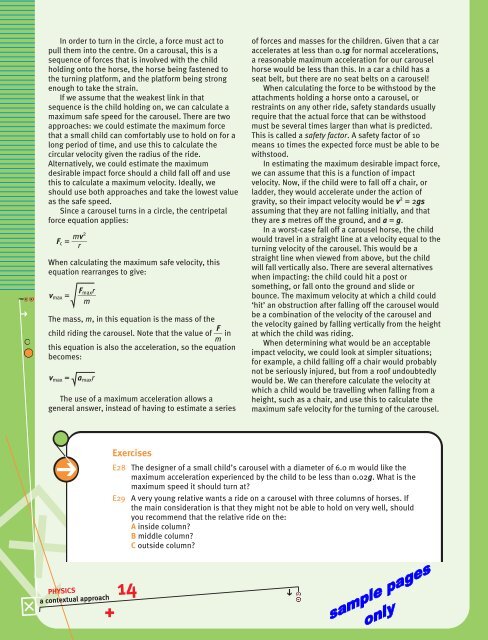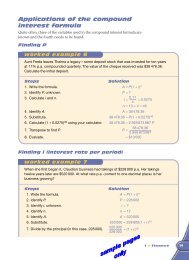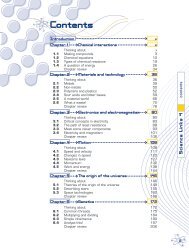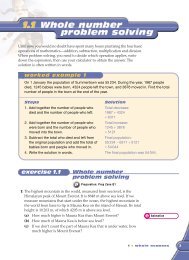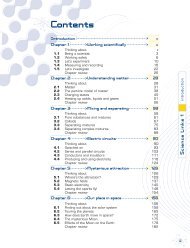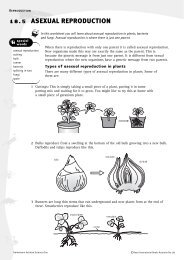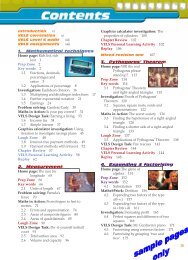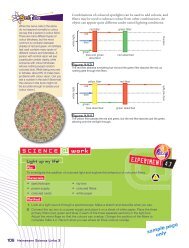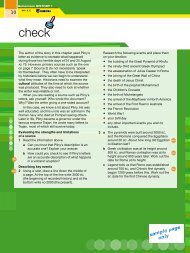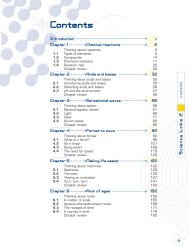Context 1: Amusement Park Physics - hi.com.au
Context 1: Amusement Park Physics - hi.com.au
Context 1: Amusement Park Physics - hi.com.au
You also want an ePaper? Increase the reach of your titles
YUMPU automatically turns print PDFs into web optimized ePapers that Google loves.
⌧<br />
<br />
➔<br />
In order to turn in the circle, a force must act to<br />
pull them into the centre. On a carousal, t<strong>hi</strong>s is a<br />
sequence of forces that is involved with the c<strong>hi</strong>ld<br />
holding onto the horse, the horse being fastened to<br />
the turning platform, and the platform being strong<br />
enough to take the strain.<br />
If we assume that the weakest link in that<br />
sequence is the c<strong>hi</strong>ld holding on, we can calculate a<br />
maximum safe speed for the carousel. There are two<br />
approaches: we could estimate the maximum force<br />
that a small c<strong>hi</strong>ld can <strong>com</strong>fortably use to hold on for a<br />
long period of time, and use t<strong>hi</strong>s to calculate the<br />
circular velocity given the radius of the ride.<br />
Alternatively, we could estimate the maximum<br />
desirable impact force should a c<strong>hi</strong>ld fall off and use<br />
t<strong>hi</strong>s to calculate a maximum velocity. Ideally, we<br />
should use both approaches and take the lowest value<br />
as the safe speed.<br />
Since a carousel turns in a circle, the centripetal<br />
force equation applies:<br />
v 2<br />
Fc = m<br />
r<br />
<br />
When calculating the maximum safe velocity, t<strong>hi</strong>s<br />
equation rearranges to give:<br />
axr<br />
vmax = Fm<br />
<br />
m<br />
The mass, m, in t<strong>hi</strong>s equation is the mass of the<br />
F<br />
c<strong>hi</strong>ld riding the carousel. Note that the value of in<br />
m<br />
t<strong>hi</strong>s equation is also the acceleration, so the equation<br />
be<strong>com</strong>es:<br />
vmax = amaxr<br />
The use of a maximum acceleration allows a<br />
general answer, instead of having to estimate a series<br />
➔<br />
PHYSICS<br />
a contextual approach<br />
Exercises<br />
of forces and masses for the c<strong>hi</strong>ldren. Given that a car<br />
accelerates at less than 0.1g for normal accelerations,<br />
a reasonable maximum acceleration for our carousel<br />
horse would be less than t<strong>hi</strong>s. In a car a c<strong>hi</strong>ld has a<br />
seat belt, but there are no seat belts on a carousel!<br />
When calculating the force to be withstood by the<br />
attachments holding a horse onto a carousel, or<br />
restraints on any other ride, safety standards usually<br />
require that the actual force that can be withstood<br />
must be several times larger than what is predicted.<br />
T<strong>hi</strong>s is called a safety factor. A safety factor of 10<br />
means 10 times the expected force must be able to be<br />
withstood.<br />
In estimating the maximum desirable impact force,<br />
we can assume that t<strong>hi</strong>s is a function of impact<br />
velocity. Now, if the c<strong>hi</strong>ld were to fall off a chair, or<br />
ladder, they would accelerate under the action of<br />
gravity, so their impact velocity would be v 2 = 2gs<br />
assuming that they are not falling initially, and that<br />
they are s metres off the ground, and a = g.<br />
In a worst-case fall off a carousel horse, the c<strong>hi</strong>ld<br />
would travel in a straight line at a velocity equal to the<br />
turning velocity of the carousel. T<strong>hi</strong>s would be a<br />
straight line when viewed from above, but the c<strong>hi</strong>ld<br />
will fall vertically also. There are several alternatives<br />
when impacting: the c<strong>hi</strong>ld could <strong>hi</strong>t a post or<br />
somet<strong>hi</strong>ng, or fall onto the ground and slide or<br />
bounce. The maximum velocity at w<strong>hi</strong>ch a c<strong>hi</strong>ld could<br />
‘<strong>hi</strong>t’ an obstruction after falling off the carousel would<br />
be a <strong>com</strong>bination of the velocity of the carousel and<br />
the velocity gained by falling vertically from the height<br />
at w<strong>hi</strong>ch the c<strong>hi</strong>ld was riding.<br />
When determining what would be an acceptable<br />
impact velocity, we could look at simpler situations;<br />
for example, a c<strong>hi</strong>ld falling off a chair would probably<br />
not be seriously injured, but from a roof undoubtedly<br />
would be. We can therefore calculate the velocity at<br />
w<strong>hi</strong>ch a c<strong>hi</strong>ld would be travelling when falling from a<br />
height, such as a chair, and use t<strong>hi</strong>s to calculate the<br />
maximum safe velocity for the turning of the carousel.<br />
E28 The designer of a small c<strong>hi</strong>ld’s carousel with a diameter of 6.0 m would like the<br />
maximum acceleration experienced by the c<strong>hi</strong>ld to be less than 0.02g. What is the<br />
maximum speed it should turn at?<br />
E29 A very young relative wants a ride on a carousel with three columns of horses. If<br />
the main consideration is that they might not be able to hold on very well, should<br />
you re<strong>com</strong>mend that the relative ride on the:<br />
A inside column?<br />
B middle column?<br />
C outside column?<br />
✚<br />
14<br />
<br />
➔


